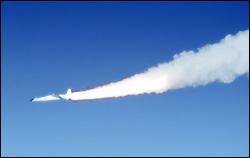NASA’s X-43A Scramjet Breaks Speed Record

Pegasus booster rocket ignites to send the X-43A on its record setting flight on Nov. 16, 2004. NASA photo <br>
X-43A research vehicle screamed into the record books again Tuesday, demonstrating an air-breathing engine can fly at nearly 10 times the speed of sound. Preliminary data from the scramjet-powered research vehicle show its revolutionary engine worked successfully at nearly Mach 9.8, or 7,000 mph, as it flew at about 110,000 feet.
The high-risk, high-payoff flight, originally scheduled for Nov. 15, took place in restricted airspace over the Pacific Ocean northwest of Los Angeles. The flight was the last and fastest of three unpiloted flight tests in NASA’s Hyper-X Program. The program’s purpose is to explore an alternative to rocket power for space access vehicles.
“This flight is a key milestone and a major step toward the future possibilities for producing boosters for sending large and critical payloads into space in a reliable, safe, inexpensive manner,” said NASA Administrator Sean O’Keefe. “These developments will also help us advance the Vision for Space Exploration, while helping to advance commercial aviation technology,” Administrator O’Keefe said.
Media Contact
More Information:
http://www.nasa.gov/missions/research/x43-main.htmlAll latest news from the category: Interdisciplinary Research
News and developments from the field of interdisciplinary research.
Among other topics, you can find stimulating reports and articles related to microsystems, emotions research, futures research and stratospheric research.
Newest articles

Self-Destructing Cancer Cells: Cutting-Edge RNA Breakthrough
Jülich scientists use novel RNA technology to selectively switch off tumours in the brain. An Adaptable Platform Technology That Destroys Glioblastoma Cancer Cells Using a special RNA molecule, a team…

Endurance Training: Transforming Lives of Heart Failure Patients
Can strength and endurance training be beneficial for patients with a certain form of heart failure? A research team from Greifswald investigated this question together with seven other research centers…

A Wake-Up Call for Mediterranean Shark Protection Against Extinction
Overfishing, illegal fishing and increasing marketing of shark meat pose significant threats to the more than 80 species of sharks and rays that inhabit the Mediterranean Sea, according to a…



